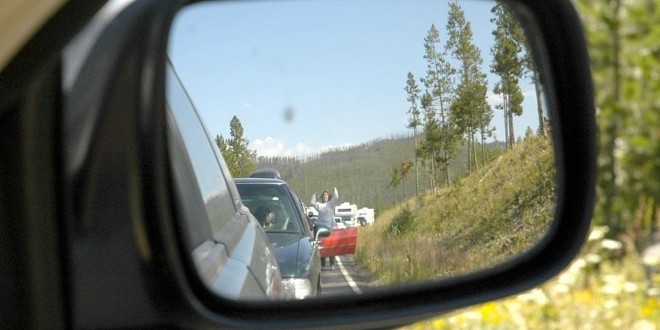Cutting back access to popular areas and curtailing services are two items on a potential makeover of Yosemite National Park. Could the same happen in the Yellowstone of the future?
Yosemite National Park is the third-most-visited national park, just ahead of Yellowstone in the rankings: about 4 million people visit Yosemite annually, while 3.4 million people visited Yellowstone in 2012. Yosemite is 1,169 square miles, as opposed to Yellowstone’s 3,472 square miles, but they both share one thing: the vast majority of visits arrive in the summer and spend most of their time in a very small section of the park. That means plenty of crowds, plenty of lines, and plenty of wear and tear on historic structures.
What the National Park Service is proposing in Yosemite is pretty drastic: spurred on by a lawsuit, the NPS is proposing a cutback of services, a restoration of natural areas and a cap on the number of visitors per day. From The New York Times:
The National Park Service is proposing a significant makeover of Yosemite National Park that would change the way future generations of visitors experienced the park, especially the seven-mile-long Yosemite Valley at its heart. The Park Service’s plan would restore more than 200 acres of meadows, reorganize transportation and reduce traffic congestion. To shrink the human presence along the Merced River, park officials are also proposing closing nearby rental facilities for bicycling, horseback riding and rafting, and removing swimming pools, an ice rink and a stone bridge….
The National Park Service early this year released the 2,500-page plan, called the Merced River Plan, in response to a long-running lawsuit charging that it was failing to preserve the river. The stretch of the Merced inside Yosemite was designated a National Wild and Scenic River in 1987 and is protected under federal law.
After the Merced flooded in 1997 and destroyed many facilities, the Park Service drew up a rebuilding plan in 2000 that would also protect the river. Two environmental groups sued the Park Service, and a succession of courts rejected the first plan as well as a revised plan in 2005. After a federal appeals court ruling in 2008, the Park Service began working on its current, third plan.
Now, there are no lawsuits pending against the NPS that would cause such drastic changes to Yellowstone National Park. But that’s not saying there will never be a time when such measures will be considered for the Park. And we’re already seeing elements of this in discussion of a Winter Plan for the Park: the same concerns and solutions in the Yosemite master plan are seen throughout winter planning.
One issue that would need to be addressed in the Yellowstone of the future: car access. To say Yellowstone visitors rely on cars is an understatement: it’s simply expected that there is car access to popular areas. And while many of us get a lot of joy from leaving that beaten Grand Loop path to seek hidden delights, the fact remains that the vast majority of Yellowstone visitors don’t want to wander too far off the Grand Loop. The total reliance on car travel has proven to be an issue for the Linx bus service, which turned a $145,000 grant from the Wyoming Department of Transportation to bring bus service to Yellowstone. Right now there’s precious little ridership on the bus service, which connects Jackson, Idaho Falls and Bozeman airports to stops along the Grand Loop Road, as the Jackson Hole News & Guide reports only four to five people per week are taking advantage of the service:
A group of 15 German tourists organized a trip using the new bus system, he said. They rode from the Jackson Hole Airport to Yellowstone, where they camped for 10 days. After their time in the park they caught a bus from Grant Village back to the airport.
But even if the service’s popularity were to grow, it doesn’t have long to turn around the numbers.
Linx depends partly on public funding to create the bus network, but the money isn’t guaranteed.
Part of the issue with Linx is the lack of marketing funds: it’s one thing to offer the service, it’s another to get the word out. And when you look at the number of folks entering Yellowstone on any given day, the amount transported by Linx is just a raindrop in the ocean. Cutting off car access will require a plan a whole lot more ambitious than the Linx bus service.
No one will like the changes in Yosemite, so you can expect a lot of complaining when someone’s favorite bike shop closes down or a family is denied access because the daily quota has been reached. But let’s say the plan works: with fewer visitors and less of an impact on nature, there will inevitably be talk about replicating that success in other busy national parks — like the Yellowstone of the future.
 Yellowstone Insider Your Complete Guide to America's First National Park
Yellowstone Insider Your Complete Guide to America's First National Park





